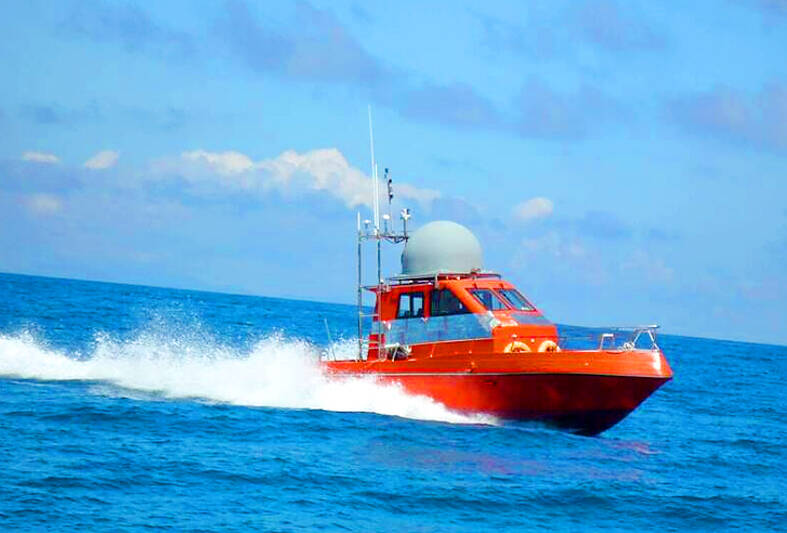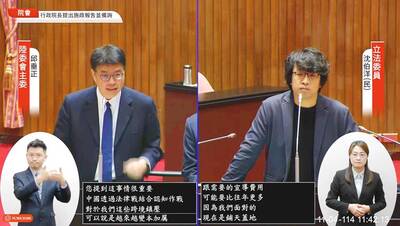Taiwan could begin mass production of maritime drones — an uncrewed surface vessel that resembles a speedboat — in 2026 if the craft developed by the Chungshan Institute of Science and Technology pass military tests, senior government officials said.
The government began developing applications of uncrewed vehicles after Ukraine used craft that can be remotely controlled to destroy Russian vessels.
The use of maritime drones makes it possible for the military to launch unexpected attacks in wartime and reduce personnel casualties, which can deter enemies, senior government officials said, adding that Taiwan has the ability to integrate uncrewed vehicles in the air, on land and under water to enhance its capabilities in reconnaissance, attacks and removing mines.

Photo: Screen grab from the institute’s Web site
The institute has recently updated the information on its Web site to say that an uncrewed target craft has been developed and used.
The target craft system is an uncrewed maritime vehicle that has remote control, preplanned routes and real-time video transmission, the institute said, adding that the craft’s functions include radio frequency simulators, radio frequency interference simulation systems, heaters, flame launchers and radar signal reflectors.
“The system has the ability to simulate radio frequency signals, interference signals, thermal radiation signals, and to scan cross-sectional areas of maritime targets. Multiple sets of target craft systems and project training courses would be combined in the military training to simulate various scenarios and effectively measure the weapon performance,” the institute said.
Radar, weapons, sonar and other modules in the target craft system can also be expanded to perform near-shore defense, attack, mine detection, submarine detection and other tasks, it said.
To counter China’s military threat, the institute has planned to invest NT$812 million (US$25.14 million) in building two uncrewed attack craft with different sizes and bomb loads, military sources said.
The remote guidance and control distance of the two uncrewed attack craft would be increased from 60km to 70km, they said.
Other sources said that attack drones built by the institute are already in mass production.
If the attack craft pass military combat tests, mass production should begin in 2026, they said, adding that the development and evaluation of uncrewed attack-type underwater vehicles are in progress.
In other developments, as the one-year compulsory conscription system is to be reimposed in January next year, the military has stepped up the production of personal combat equipment and individual weapon systems.
Taiwan’s army has purchased more than 100,000 Kestrel rocket launchers from the institute, military sources said.
Voluntary and compulsory service officers and soldiers serving in the anti-armor company of the ground forces and related units would get to experience using actual Kestrel rocket launchers to strengthen the nation’s anti-armor combat capability, they said.
Kestrel rockets are anti-armor individual rockets developed by the institute and adopt a disposable launch tube design that can reduce the burden on officers and soldiers. The rocket system costs about NT$100,000 per unit as massive production has driven down production costs. The rockets also have optical targeting and night vision functions to meet combat needs. Officers and soldiers can use anti-armor rockets or attack rockets, depending on the mission. Their maximum shooting range is 1,200m and the effective range is 400m. The attack rockets can penetrate a 30cm-thick brick wall.

CALL FOR SUPPORT: President William Lai called on lawmakers across party lines to ensure the livelihood of Taiwanese and that national security is protected President William Lai (賴清德) yesterday called for bipartisan support for Taiwan’s investment in self-defense capabilities at the christening and launch of two coast guard vessels at CSBC Corp, Taiwan’s (台灣國際造船) shipyard in Kaohsiung. The Taipei (台北) is the fourth and final ship of the Chiayi-class offshore patrol vessels, and the Siraya (西拉雅) is the Coast Guard Administration’s (CGA) first-ever ocean patrol vessel, the government said. The Taipei is the fourth and final ship of the Chiayi-class offshore patrol vessels with a displacement of about 4,000 tonnes, Lai said. This ship class was ordered as a result of former president Tsai Ing-wen’s (蔡英文) 2018

‘SECRETS’: While saying China would not attack during his presidency, Donald Trump declined to say how Washington would respond if Beijing were to take military action US President Donald Trump said that China would not take military action against Taiwan while he is president, as the Chinese leaders “know the consequences.” Trump made the statement during an interview on CBS’ 60 Minutes program that aired on Sunday, a few days after his meeting with Chinese President Xi Jinping (習近平) in South Korea. “He [Xi] has openly said, and his people have openly said at meetings, ‘we would never do anything while President Trump is president,’ because they know the consequences,” Trump said in the interview. However, he repeatedly declined to say exactly how Washington would respond in

WARFARE: All sectors of society should recognize, unite, and collectively resist and condemn Beijing’s cross-border suppression, MAC Minister Chiu Chui-cheng said The number of Taiwanese detained because of legal affairs by Chinese authorities has tripled this year, as Beijing intensified its intimidation and division of Taiwanese by combining lawfare and cognitive warfare, the Mainland Affairs Council (MAC) said yesterday. MAC Minister Chiu Chui-cheng (邱垂正) made the statement in response to questions by Democratic Progressive Party (DPP) Legislator Puma Shen (沈柏洋) about the government’s response to counter Chinese public opinion warfare, lawfare and psychological warfare. Shen said he is also being investigated by China for promoting “Taiwanese independence.” He was referring to a report published on Tuesday last week by China’s state-run Xinhua news agency,

‘ADDITIONAL CONDITION’: Taiwan will work with like-minded countries to protect its right to participate in next year’s meeting, the foreign ministry said The US will “continue to press China for security arrangements and protocols that safeguard all participants when attending APEC meetings in China,” a US Department of State spokesperson said yesterday, after Beijing suggested that members must adhere to its “one China principle” to participate. “The United States insists on the full and equal participation of all APEC member economies — including Taiwan — consistent with APEC’s guidelines, rules and established practice, as affirmed by China in its offer to host in 2026,” the unnamed spokesperson said in response to media queries about China putting a “one China” principle condition on Taiwan’s